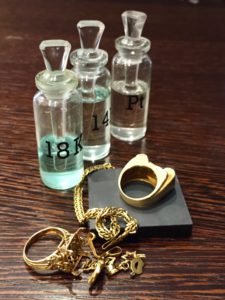 We practice buying /redeeming gold for cash. For this, we have implemented a simple procedure that guarantee a maximum of transparency. At Héritage de France, we are aware that it is not easy for you to evaluate the value of the gold you have to sell. Here is how we proceed for the purchase of gold in our jewelry store in Paris:
We practice buying /redeeming gold for cash. For this, we have implemented a simple procedure that guarantee a maximum of transparency. At Héritage de France, we are aware that it is not easy for you to evaluate the value of the gold you have to sell. Here is how we proceed for the purchase of gold in our jewelry store in Paris:
· We receive you with your gold for sale "in bulk"
· We check if the objects / jewelry are hallmarked and what is their titration (18ct gold, 14ct, platinum, silver, etc.).
· We select items / jewelry of interest as they can be sold for a higher value than gold. This is the case for some antique jewelry that are set with precious stones or pearls. Signed jewelry do also often worth more than the value of gold.
· The remaining gold is weighed on an accurate scale.
· We check the gold value of the day and make you a buying offer. If you accept it, we establish a bank check immediately.
All of this is of course free of charge, whether you accept or reject our buying offer. All the expertise is made in your presence, so that you can follow each step and ask questions about our procedure.
If you have any questions regarding the sale of your gold or jewelry, do not hesitate to call us or send us an email, we will answer as soon as possible.
If you wish, you can send us pictures of your jewelry before coming to our store. This can give you an idea of ??the interest we can have in your jewelry as well as a potential estimate of their value. You can send us your pictures (as clear as possible ...) to david@heritage-de-france.com.
Little trick: put your jewels next to a millimetric ruler.
If you have a large number of jewelry to assess, it is best to call us beforehand to make an appointment because the procedure is likely to take a little time.
Our opening hours and contact information are available here.
See also the legislation concerning the sale of gold.